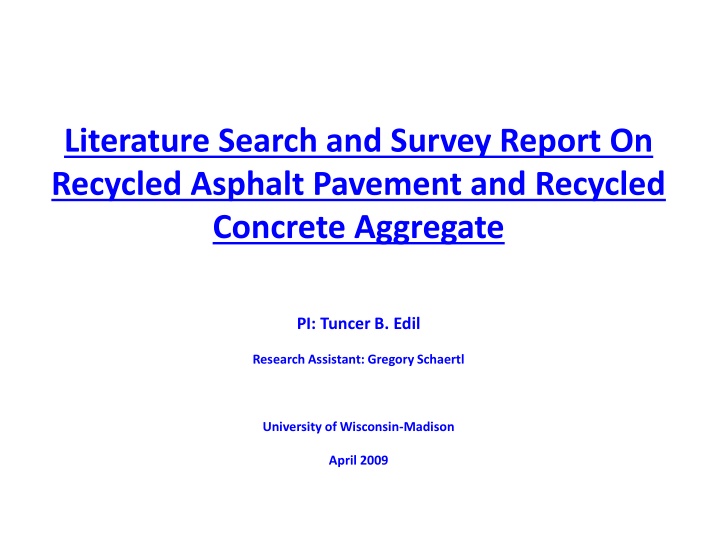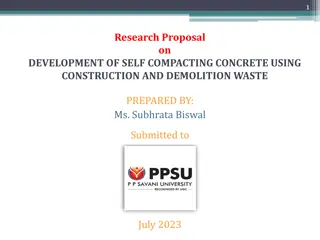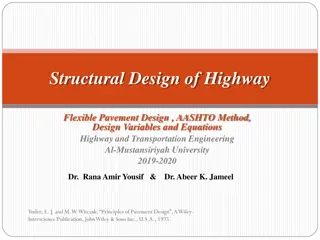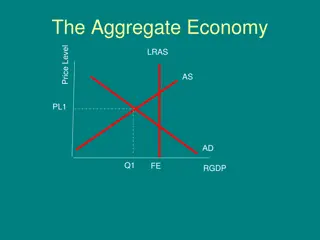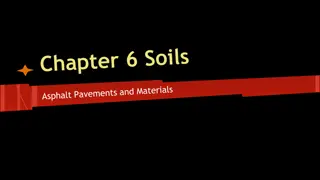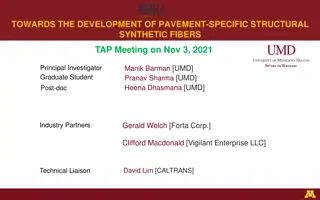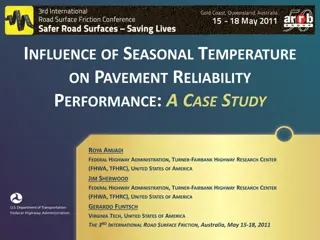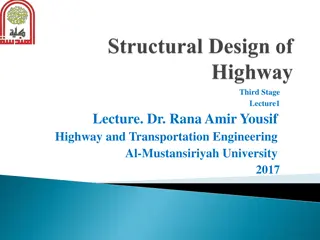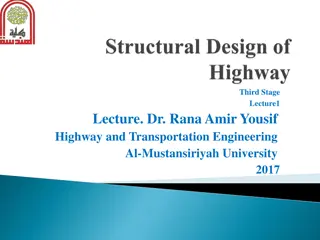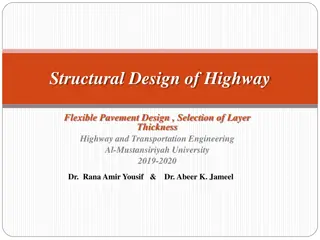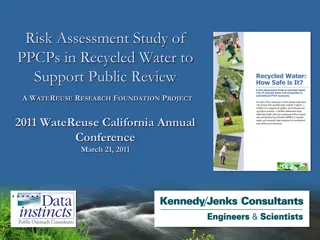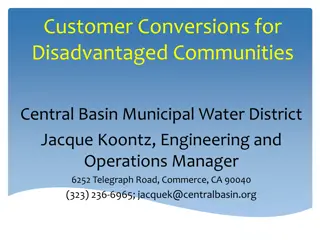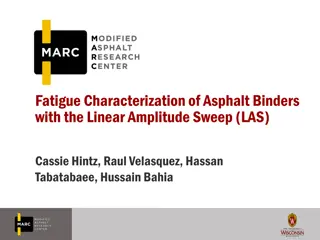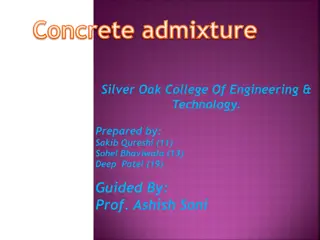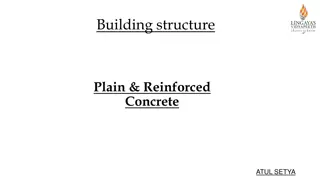Recycled Asphalt Pavement and Recycled Concrete Aggregate: Survey Report
This survey report explores the production and properties of Recycled Asphalt Pavement (RAP) and Recycled Concrete Aggregate (RCA). It discusses the materials, nomenclature ambiguity, and physical properties of RAP and RCA, shedding light on their production methods, mechanical and physical characteristics. The report aims to provide valuable insights into the utilization of RAP and RCA in construction projects.
Download Presentation

Please find below an Image/Link to download the presentation.
The content on the website is provided AS IS for your information and personal use only. It may not be sold, licensed, or shared on other websites without obtaining consent from the author.If you encounter any issues during the download, it is possible that the publisher has removed the file from their server.
You are allowed to download the files provided on this website for personal or commercial use, subject to the condition that they are used lawfully. All files are the property of their respective owners.
The content on the website is provided AS IS for your information and personal use only. It may not be sold, licensed, or shared on other websites without obtaining consent from the author.
E N D
Presentation Transcript
Literature Search and Survey Report On Recycled Asphalt Pavement and Recycled Concrete Aggregate PI: Tuncer B. Edil Research Assistant: Gregory Schaertl University of Wisconsin-Madison April 2009
Materials Some ambiguity exists regarding the nomenclature for Recycled Asphalt Pavement Production. A suggested nomenclature: Recycled Asphalt Pavement (RAP) Removal and Reuse of Hot Mix Asphalt (HMA) Layer Full Depth Reclamation (FDR) Removal and Reuse of HMA and Entire Base Course Layer Recycled Pavement Material (RPM) Removal and Reuse of HMA and Part of the Base Course Layer HMA, the Entire Base Course Layer, and Part of the Underlying Subgrade These three materials are often collectively referred to as RAP
Materials Recycled Concrete Aggregate (RCA) Product of demolition and reprocessing of existing concrete structures (buildings, roads, runways, etc.) Cementitious coating increases water absorption Un-Hydrated cement in material can increase strength and durability Produced by crushing only Particle size distribution depends on crushing methods Recycled Asphalt Pavement (RAP) Product of removal and reprocessing of existing asphalt pavement Bituminous coating reduces water absorption Produced by milling and crushing High fines due to milling and crushing in production
Typical Physical Properties of RAP Physical Properties Unit Weight 1940 - 2300 kg/m3 (120 - 140 pcf) Normal: Up to 5% Moisture Content Maximum: 7 - 8% Normal: 4.5 6% Normal: 10 80% at 25 C (77 F) Normal: 4000 25000 poises at Asphalt Content Asphalt Penetration Absolute Viscosity or Recovered Asphalt Cement 60 C (140 F) Mechanical Properties Compacted Unit Weight 1600 2000 kg/m3 (100 125 pcf) 100% RAP: 20 25% California Bearing Ratio (CBR) 40% RAP and 60% Natural Aggregate: 150% or Higher
Typical Physical Properties of RCA Physical Properties 2.2 to 2.5 (Coarse Particles) Specific Gravity 2.0 to 2.3 (Fine Particles) 2 to 6 (Coarse Particles) Absorption 4 to 8 (Fine Particles) Mechanical Properties LA Abrasion Loss 20 to 45 (Coarse Particles) Magnesium Sulfate Soundness 4 or Less (Coarse Particles) Loss Less than 9 (Fine Particles) California Bearing Ratio (CBR) 94 to 148%
Summary of Material Gradations RAP Fines (Passing #200 Sieve): 1 to 8% Average: 2.3% / Standard Deviation: 2.7% Coarse (Passing 3/4 Sieve): 92 to 100% Average: 95.0% / Standard Deviation: 3.8% RPM Fines: 3 to 16% Average: 8.0% / Standard Deviation: 3.8% Coarse: 93 to 96% Average: 95.8% / Standard Deviation: 1.5% RCA Fines: 3 to 8% Average: 5.1% / Standard Deviation: 1.7% Coarse: 50 to 100% Average: 82.4% / 14.8%
Maximum Dry Density and Optimum Moisture Content of RAP and RPM Maximum Dry Optimum Moisture Material Proctor Effort Density, kg/m3 Content, % Caltrans Bejarano: Pulverized (8) 2332 5.5 CTM 216 Standard Modified Modified Bennert RAP(3) Guthrie R1(6) Guthrie R2(6) 1872 2083 1842 5 5.6 5.8 Standard Saeed RAP-LS-MS(9) 1988 6.3 Standard Saeed RAP-GR-CO(9) 2015 10.3 Standard Saeed RAP-GV-LA(9) 1978 5.4 Standard Modified Carmargo RPM(11) Wen et al(13) 2161 2162 7.5 7.5
Maximum Dry Density and Optimum Moisture Content of RCA Maximum Dry Optimum Moisture Material Proctor Effort Density, kg/m3 Content, % Bennert RCA(3) Standard 1984 7.5 Blankenagel Modified 1830 9.7 Demolition(5) Blankenagel Haul Modified 2020 10.6 Back(5) Saeed RCP-LS-IL(9) Standard 1971 11 Saeed RCP-GV-LA(9) Standard 1950 9 Saeed RCP-GR-SC(9) Standard 1990 9.5 Kuo UCF(2) Modified 1823 11.2 Kuo FDOT(2) Modified 1839 12.1
Summary of Moisture-Density Characteristics Pure aggregate had higher MDD than pure RAP or pure RCA (Saeed) Compaction specimens prepared by Gyratory Compaction (GCT) correlated to field measurements better than specimens prepared by Proctor Compaction (PCT) (Kim) Increased RAP content in RAP-Aggregate blends led to decreased Maximum Dry Density (MDD) and decreased Optimum Moisture Content (OMC) (Guthrie, Kim, Bennert, Saeed) RAP-Aggregate blends compacted by GCT showed no decrease in MDD with increased RAP content (Kim) Increased RCA content in RCA-Aggregate blends led to decreased MDD and increased OMC (Bennert, Saeed) Haul-back material had higher MDD and OMC than demolition material (Blankenagel)
Summary of Strength Tests Static Triaxial Tests: Shear strengths of RAP and Aggregate were comparable in magnitude for tests under varying confining pressures (Bejarano) Shear strength greater for pure Aggregate than for pure RAP or pure RCA (Bennert) Shear strength in RAP or RCA - Aggregate blends decreased as RAP or RCA content increased (Bennert) CBR Tests: Shear strength in RAP Aggregate blends decreased as RAP content increased (Guthrie) RPM had lower strength than aggregates with similar gradation (Camargo, Wen)
Summary of Stiffness Tests Stiffness Resilient Modulus (Mr): Pure RAP and pure RCA specimens had a higher Mr than pure aggregate tested at the same compaction level (Bejarano, Bennert) RAP / RCA Aggregate blends had increased Mr with Increased RAP and RCA content (Bennert, Kim) Increased confining pressure for RAP-Aggregate blends resulted in increased Mr and increased permanent deformation (Kim) Pure aggregate and 50/50 RAP-Aggregate blends had equivalent stiffness at low confining pressures; blended material had greater stiffness at high confining pressures (Kim) Increased compressive strength of RCA resulted in increased Mr (Naatmadja) Plastic strains for RPM may be higher or lower than those of conventional base aggregates (Camargo) Addition of Fly Ash to RPM increased Mr; Mr further increased with additional fly ash and curing time (Carmago)
Summary of Stiffness Tests Stiffness Free-Free Resonant Column Test: The stiffness of RAP-Aggregate blends decreased from 0-25% RAP and increased from 25-100% RAP. Trend reversed after 72 hours drying: stiffness increased from 0-25% RAP and decreased from 25- 100% RAP (Guthrie)
Summary of Other Tests Moisture Susceptibility Tube Suction Tests: Moisture susceptibility in RAP-Aggregate blends increased with increased RAP content (Guthrie) Dry density of RAP-Aggregate blends decreased with increased RAP content (Guthrie) Durability LA Abrasion Tests: Demolition material experienced higher material losses than Haul-Back material (Blankenagel) Commercial RCA had a lower hardness compared to laboratory manufactured RCA (Nataatmadja) Freeze-Thaw Tests: RCA experienced a 30 to 90% reduction in stiffness, and a 28 to 52% reduction in strength (Blankenagel) RPM and aggregate with and without fly ash experienced a decrease in stiffness of less than 15%, with no consistent effect for materials stabilized with fly ash (Camargo, Wen)
Conclusions GCT specimens correlate more closely to field density measurements than PCT specimens Pure aggregate and 50/50 RAP/Aggregate blends had equivalent stiffness at low confining pressures, but blends had greater stiffness at high confining pressures RAP and RCA have higher Mr than pure aggregate, but pure aggregate has higher shear strength than RAP or RCA Increased RAP and RCA content in aggregate blends results in decreased shear strength and increased Mr Plastic strains for RPM may be higher or lower than those of conventional base aggregates RPM shows better response than natural aggregate for similar gradation and compaction tests
The Usage, Storage and Testing of Recycled Materials Results of Survey PI: Tuncer B. Edil Research Assistant: Gregory Schaertl University of Wisconsin-Madison April 2009
Which of the following recycled materials do you use as a granular base course? Number of Responses Total Responses: 34 Recycled Asphalt Pavement (RAP): 18 (53%)* Recycled Concrete Aggregate (RCA): 30 (88%)* Recycled Pavement Material (RPM): 17 (50%)* *More than one response possible
Which of the following recycled materials do you use as a granular base course? 35 30 25 Number of Responses 20 15 10 5 0 RAP RCA RPM Material Type
When are the recycled materials used? Number of Responses Total Responses: 36
When are the recycled materials used? Number of Responses Recycled Asphalt Pavement (RAP) Total Responses: 26 Stockpiled and Used Later, 11, 42% Both, 14, 54% Used in Place Immediately1, 4%
When are the recycled materials used? Number of Responses Recycled Concrete Aggregate (RCA) Total Responses: 31 Both, 11, 34% Stockpiled and Used Later, 20, 63% Used in Place Immediately, 1, 3%
When are the recycled materials used? Number of Responses Recycled Pavement Material (RPM) Total Responses: 18 Stockpiled and Used Later, 6, 33% Both, 7, 39% Used in Place Immediately, 5, 28%
In a given year, how much of the recycled material do you use? Number of Responses Total Responses: 33
In a given year, how much of the recycled material do you use? Number of Responses Recycled Asphalt Pavement (RAP) Total Responses: 23 Less than 1,000 Tons, 4, 18% 1,000 to 5,000 Tons, 0, 0% More than 75,000 Tons, 12, 52% 5,000 to 10,000 Tons, 2, 9% 10,000 to 25,000 Tons, 4, 17% 25,000 Tons to 50,000 Tons, 0, 0% 50,000 Tons to 75,000 Tons, 1, 4%
In a given year, how much of the recycled material do you use? Number of Responses Recycled Concrete Aggregate (RCA) Total Responses: 29 Less than 1,000 Tons, 2, 7% More than 75,000 Tons, 8, 27% 1,000 to 5,000 Tons, 6, 21% 50,000 Tons to 75,000 Tons, 2, 7% 5,000 to 10,000 Tons, 4, 14% 25,000 Tons to 50,000 Tons, 5, 17% 10,000 to 25,000 Tons, 2, 7%
In a given year, how much of the recycled material do you use? Number of Responses Recycled Pavement Material (RPM) Total Responses: 18 Less than 1,000 Tons, 1, 5% More than 75,000 Tons, 4, 22% 1,000 to 5,000 Tons, 4, 22% 50,000 Tons to 75,000 Tons, 2, 11% 5,000 to 10,000 Tons, 3, 17% 25,000 Tons to 50,000 Tons, 1, 6% 10,000 to 25,000 Tons, 3, 17%
How long have you been using the recycled materials? Number of Responses Total Responses: 34
How long have you been using the recycled materials? Number of Responses Recycled Asphalt Pavement (RAP) Total Responses: 26 Less than 1 Year, 0, 0% 1 to 2 Years, 0, 0% More than 10 Years, 20, 77% 2 to 5 Years, 1, 4% 5 to 10 Years, 5, 19%
How long have you been using the recycled materials? Number of Responses Recycled Concrete Aggregate (RCA) Total Responses: 29 Less than 1 Year, 0, 0% More than 10 Years, 18, 62% 1 to 2 Years, 0, 0% 2 to 5 Years, 4, 14% 5 to 10 Years, 7, 24%
How long have you been using the recycled materials? Number of Responses Recycled Pavement Material (RPM) Total Responses: 20 Less than 1 Year, 1, 5% More than 10 Years, 12, 60% 1 to 2 Years, 0, 0% 2 to 5 Years, 4, 20% 5 to 10 Years, 3, 15%
Are any of the following tests used in specifications for the material? Number of Responses Total Responses: 32
Are any of the following tests used in specifications for the material? 30 26 25 Number of Responses 20 Grain Size Analysis: Dry Sieve 20 Grain Size Analysis: Wet Sieve and Hydrometer 16 15 Liquid Limit 11 Plastic Limit and Plasticity Index 10 8 5 4 5 2 1 1 1 0 0 RAP RCA RPM Material Type
Which of the following aggregate quality tests for shear strength do you perform on the material prior to placement? Number of Responses Total Responses: 11
Which of the following aggregate quality tests for shear strength do you perform on the material prior to placement? 5 Static Triaxial Test 4 4 Number of Responses California Bearing Ratio 3 Dynamic Cone Penetrometer w/ Lightweight Deflectometer 2 2 2 Resistance Value 1 1 1 1 1 1 1 1 1 1 Pre-Qualify with Los Angeles Abrasion and Sulfate Soundness (5 cycles): Sand Equivelancy Test 0 0 0 0 0 0 0 0 0 0 RAP RCA RPM Material Type
Which of the following aggregate quality tests for toughness do you perform on the material prior to placement? Number of Responses Total Responses: 21
Which of the following aggregate quality tests for toughness do you perform on the material prior to placement? LA Abrasion 16 15 15 Aggregate Impact Value 14 13 Number of Responses 12 Aggregate Crushing Value Aggregate Abrasion Value Micro-Deval 11 10 9 8 7 6 5 5 5 Durability Mill 4 3 2 2 Gyratory Test 2 1 1 1 1 1 1 1 0 0 0 0 0 0 0 0 0 0 0 0 0 0 0 0 Sulfate Soundness 0 RAP RCA RPM Texas Wet-Mill (Similar to Micro-Deval) Material Type
Which of the following aggregate quality tests for durability do you perform on the material prior to placement? Number of Responses Total Responses: 12
Which of the following aggregate quality tests for durability do you perform on the material prior to placement? 9 8 8 7 Number of Responses Sulfate Soundness 6 Canadian Freeze- Thaw Aggregate Durability Index Magnesium Sulfate Soundness 5 4 3 3 2 2 1 1 1 1 0 0 0 0 0 0 0 RAP RCA RPM Material Type
Responses for the following aggregate quality tests were inconclusive Stiffness Frost Susceptibility Permeability Mineralogical Composition Particle Geometric Properties
Conclusions RCA most commonly used material, followed by RAP and RPM If RAP and RPM are combined, recycling of flexible pavements is more common in terms of frequency and quantity Following reclamation operations, it is more common for a recycled material to be stockpile and used later than to be used immediately after reclamation (relatively, RPM is most likely to be used immediately after reclamation) RAP represents the greatest total tonnage used, followed by RCA and RPM
Conclusions Common Tests: Specification Compliance: Grain Size Analysis (Dry/Wet Sieve), Plastic/Liquid Limit Shear Strength: California Bearing Ratio Aggregate Toughness: LA Abrasion Aggregate Durability: Sulfate Soundness Less Common Tests: Stiffness: R-Value Permeability: Falling Head Test Mineralogical Composition: Petrographic Examination Particle Geometry: Percent of Fractured Particles Test or Flat and Elongated Particles Test
Conclusions Overall: Data regarding structural qualities of aggregates is limited Recommend development of database of such properties for recycled materials
Discussion Points RAP nomenclature? Compaction specifications to be used in the tests? Need for structural properties, i.e., resilient modulus and plastic strains? Aggregate quality test for toughness: LA abrasion? Aggregate quality test for durability: Sulfate soundness? Frost susceptibility: UW approach?
